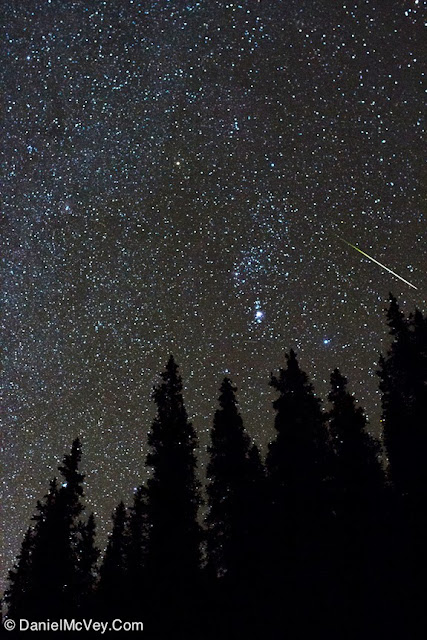Orionid meteor Over Summit County, CO
Astrophotographer Daniel McVey took this photo of an Orionid meteor in Summit County, CO, Oct. 21, 2012.
Credit: Daniel McVey
The Orionid meteor shower takes place in October and November each year, peaking in mid-October. The Orionids are noted for being bright and quick fragments, according to NASA, with an average speed of about 148,000 mph (238,000 kph.) However, this year's shower, predicted for the night of Oct. 20-21, may be spoiled by moonlight.
Orionids, like all meteor showers, are named after the constellation in which they appear to come from, which in this case is Orion the Hunter. While the constellation is best visible in the Northern Hemisphere, the meteor shower is visible in both the northern and southern hemispheres. Orion's location is:
- Right ascension: 5 hours
- Declination: 5 degrees
- Latitudes: Between 85 and -75 degrees
"The Orionids are also framed by some of the brightest stars and planets in the night sky, which lend a spectacular backdrop for these showy meteors," NASA wrote on a web page about the annual shower.
Remnants from this shower, as well as the Eta Aquarids in May, come from Halley's Comet. The comet is the most famous "periodic" visitor to the inner solar system, swinging by the sun every 76 years. It was last visible from Earth in 1986, and will not approach the area again until 2061. The comet leaves behind a debris trail of small fragments, into which Earth plows twice a year.
'Visible throughout the night sky'
Although meteors can look bright in the night sky, they result from very small fragments of comets and other debris. A typical meteor fragment is the size of a dust grain, or perhaps a tiny pebble. In the case of the Orionids, these fragments came from Halley's Comet as it approached the sun. The heat of the sun melts the conglomeration of ices on comets as they approach, leaving a trail of dust and debris in the comet's wake.
The meteor shower results when our planet plows into the dust trail left behind by Halley. From Earth's perspective, the comet fragments appear to come approximately from the direction of Betelgeuse, a bright red supergiant star in Orion. However, NASA says, staring at the direction of Orion will make you miss a lot of meteors.
"They are visible throughout the night sky," the agency wrote. "It is actually better to view the Orionids at least 90 degrees away from the radiant. They will appear longer and more spectacular from this perspective. If you do look directly at the radiant, you will find that the meteors will be short — this is called foreshortening."
The moon so bright
The meteor shower of 2013, however, may be spoiled by moonlight. This year's Orionid meteor shower is predicted for the night of Oct. 20-21, only two days past the full moon, wrote SPACE.com Skywatching columnist Joe Rao. Even under good conditions, the Orionids are dim enough to be difficult to see in city lights or even the suburbs, Rao wrote in 2012. "Typically, Orionid meteors are normally dim and not well seen from urban locations, so we suggest that you find a safe rural location to see the best Orionid activity," he said.
The Orionids usually put on the best show around 1 a.m. or 2 a.m. local time until dawn, when Betelgeuse reaches its peak height above the southern horizon. At its peak, the shower sends 15 to 20 meteors per hour across the sky. Additionally, skywatchers can expect to see 5 to 10 sporadic meteors an hour on any night.


No comments:
Post a Comment